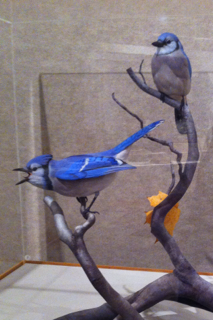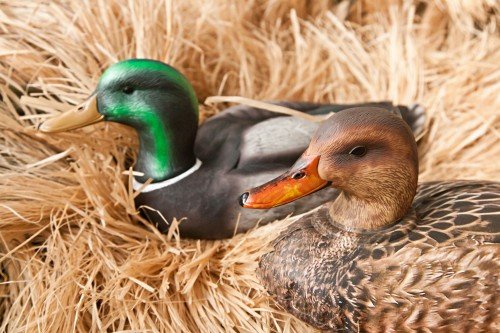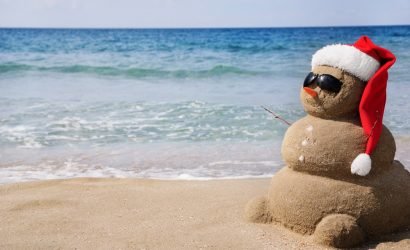Too often, The Ward Museum of Wildfowl Art in Salisbury remains a place that seems to constantly elude us. We are often stuck at a stoplight across the street from the museum straining our necks to catch a glimpse of it. Other times we see signs and advertisements, reminding us that a Day Trip is most certainly in order. ShoreBread decided that we could wait no longer, making the decision to brighten a gloomy day last week with a Day Trip to the wildfowl art museum.
The Ward Museum was established in 1968 as a place to promote wildlife conservation, as well as, the artistic and historical aspects of bird decoys. Shortly stated, it’s a place that holds birds in high esteem. As soon as you exit the parking lot, you are greeted by bronzed statues of fierce looking birds of prey, lining the walkway to the interior.
Once inside, visitors cannot help but notice the beautiful views allotted for the building’s architectural design. The building’s large windows overlook a spot on Schumaker Pond where the water has been slowed down to create a safe and tranquil spot for birds to rest. Naturally, many different kinds of waterfowl flock to this area and float conveniently within view of the museum. The staff must also work hard to keep other birds fed all winter as well; we spotted many bird tracks in the snow on our visit and quickly deemed the museum an excellent bird watching spot, both inside and out.
After looking around outside, we decided to set out to see what we came for – to see what exhibits were waiting for us inside! Our first stop was a corridor providing a thorough history of waterfowl decoys. Did you know Native Americans used decoys? According to the museum, Native Americans made bird replicas out of reeds and feathers to mimic actual bird characteristics. The Native Americans also taught early European settlers how to use decoys. When settlers arrived in the New World, they were shocked at how many birds that they had available to them for hunting. In England and other European countries, game was owned by the government, and as a result, only elite members of society were permitted to hunt. However in America, the settlers could enjoy sport at any time they pleased.
The museum also covered different aspects of waterfowl hunting and how it changed over the years. Naturally, the weapons that were used evolved over time dramatically. Native Americans originally used spears to catch birds until they progressed to using bow and arrows, which made catching birds much easier. Soon, Native Americans were using a more advanced type of arrow, specifically called a “bird head” that was very small and efficient in bird hunting. Next, settlers began using various kinds of guns, including an enormous rifle that was so long that we couldn’t even snap an accurate photo to share. In 1900, a repeating shot gun was used that could fire 10 shots without reloading and could kill up to 100 birds in a day.
Our favorite invention was a boat that laid flat on the water, almost like a piece of floating cardboard, with decoys lining the boat’s surface. This gave the impression that the birds were floating on top of the water. However the boat also had an indent where the hunter could lay down and not be seen so that anytime he floated near a bird, he could sit up and shoot. While this was a pretty inventive creation, it also could be dangerous, as the huntsmen floated in a small mostly unprotected boat.
Next, we walked into a gallery-style room that displayed many intricately crafted bird sculptures. The works of art were truly remarkable and looked extremely life-like. It’s difficult to wrap your head  around the idea that artists can actually sculpt wood to look so true to life. Other sculptures caught birds in flight and in various stages of movement. The sculptures appear so completely natural that itis as if the birds were frozen in time. We have to admit that the statue of two snow geese taking off in flight gave us a little start as it looked like the giant birds were flying directly at us.
around the idea that artists can actually sculpt wood to look so true to life. Other sculptures caught birds in flight and in various stages of movement. The sculptures appear so completely natural that itis as if the birds were frozen in time. We have to admit that the statue of two snow geese taking off in flight gave us a little start as it looked like the giant birds were flying directly at us.
After the gallery, we meandered into a separate room that showcased many duck decoys and featured a replica of a decoy workshop. This exhibit was designed to reflect what a typical place of work would have looked like for the Ward brothers, for whom the museum is named.
Stephen Ward and Lemuel T. Ward Jr. were barbers by trade but decoy makers at heart. They first began carving and painting at a young age, inspired by their father, Lemuel Ward Sr., who actually began creating the innovative flat bottom decoys that were rarely used prior to his time. These decoys differed from the commonly used round bottom decoys that bobbed on the water, while the flat bottomed decoy floated more naturally like a waterfowl.
The Ward brothers continued to create decoys and soon watermen began buying them as hunting accessories. These wooden birds were often simply carved, by Stephen, and painted, by Lem, without a heavy focus on detail as a way to produce many decoys to keep up with demand. Later, after the brothers received notoriety for their craftsmanship, their wooden decoys were no longer needed to lure in birds, but were used instead for decoration.
Once their craft became an art form, the brothers were able to take more time to make creative and sophisticated decoys. When he was not in the workshop, Lem would spend his time studying birds in the wild, taking in their colors and movements so that he could make his creations as realistic as possible. Many local watermen actually questioned why the Ward brothers would let birds swim around their decoys but never shoot at them.
The brothers’ creative ventures caused them to become inspirations to other artists, lending them fame in the wildfowl art world. Some of the many awards and honors that the Ward brothers received include being featured in the September1964 issue of National Geographic, being awarded honorary doctorates in 1972 by Salisbury State College (now Salisbury University) and the National Endowment for Arts’ National Heritage Fellowship in 1983 (which made Lem a nationally recognized artist).
Visiting the Ward Museum was a great day trip that taught us about a significant part of our waterfowl history on the Eastern Shore while simultaneously giving us a look at beautiful, unique art. We can’t wait to come back and enjoy the scenic view again, while attending one of the many events that the museum hosts.







